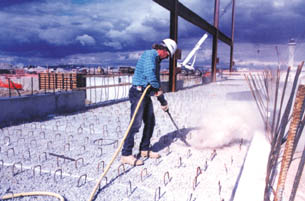New focus on 'appalling' hazard: silica dust
Date Posted: November 24 2000
It's not every week or even every year that a national publication devotes so much attention to a serious medical problem that affects building trades workers.
So it was good to see a cover story in the Nov. 13 issue of The Engineering News Record under the headline, "The Scourge of Silicosis."
The lengthy article didn't come out with any new revelations, studies, or fixes for the disease, which kills about 250 construction workers every year. But it did provide a valuable public service to the building trades workers who are potentially affected by the disease, by pointing out the hazard to the nation's construction engineering and contractor communities.
"Kids play in it, masons mortar with it, painters blast with it and operating engineers push it around with equipment," the ENR article began. "Sand and other aggregates containing silica can be benign and productive building materials when used properly, but they can be slow and silent killers when workers on construction sites and in quarries chronically breathe the airborne dust from the products. The resulting silicosis is an ancient disease that causes scarring in the lungs, reduced lung capacity, heart problems and even death."
Silicosis is similar to asbestos in that it sometimes takes years to manifest itself, is difficult to diagnose and can be prevented with the proper personal protective equipment or engineering controls.
"Inhalation of fine particles of crystalline silica produces a scarring in the lung (that) acts as a barrier and causes difficulty in moving air in and out and prevents getting oxygen from getting into the blood stream," said Dr. Stephen Levin, medical director of Mt. Sinai­Irving J. Selikoff Center for Occupational and Environmental Medicine in New York. "The more dust inhaled, the more scarring there is."
Heart disease, the ENR pointed out, is a companion problem. "Silicosis can destroy blood vessels that run through the lung and cause back pressure on the right side of the heart, which is the side that pumps blood to the lungs," said Levin. Silicosis "will stiffen lungs, narrow airways and cause shortness of breath and coughing. In severe cases, victims end up with pulmonary impairment to the point that they have to go on oxygen."
There's nothing new about the knowledge of the hazards of silica dust. According to the Center to Protect Workers Rights, which is the health and safety arm of the AFL-CIO Building Trades Department, in the 1940s, a North Carolina industrial hygienist named M.F. Trice prepared a groundbreaking paper on safeguarding health in construction.
Long before others, he examined many of the hazards and came to the same conclusions that health experts realize today. That is, the silica dust hazard can be minimized with the substitution of materials, using wet methods when dealing with dust, and utilizing exhaust ventilation, personal respiratory protection and improved design of tools. Even today, the National Institute for Occupational Safety and Health has not been able to improve on these recommendations.
Trice describes silica dust as the "most important" health hazard in construction work. He said constant exposure to silica dust causes a chemical reaction that "completely destroys" the lungs and leaves victims of the disease of silicosis "extremely susceptible to pulmonary tuberculosis" and an "early death."
OSHA guidelines on working around silica dust remain behind the times. But in 1996, the wheels were put into motion by former Labor Department Secretary Robert Reich to improve the silica standard. This came after the International Agency for Research on Cancer, in a controversial decision, concluded "there was sufficient evidence" to categorize certain kinds of silica as a carcinogen. Predictably, the decision was met with resistance from business groups such as the National Industrial Sand Association.
The existing standard for silica exposure is out of the 1960s and actually pre-dates OSHA. It is an inadequate and unenforceable standard because it contains obsolete sampling language in terms of millions of particles per cubic feet of air - no longer valid because modern monitoring devices are set up using the metric system.
In any case, OSHA is slowing moving toward an enforceable standard that would essentially cut the permissible exposure limit in half. Building trades unions like the bricklayers and painters are at the forefront of helping government agencies set up a new standard.
"In terms of life-years lost, silicosis is a bigger problem than asbestosis," said Pam Susi, an industrial hygienist who is director of the CPWR's Exposure Assessment Program. "We hear about guys in their 40s dying now from an ancient disease. It is appalling."

SANDBLASTING Hardhats need to be aware of the dangers of silica dust.
